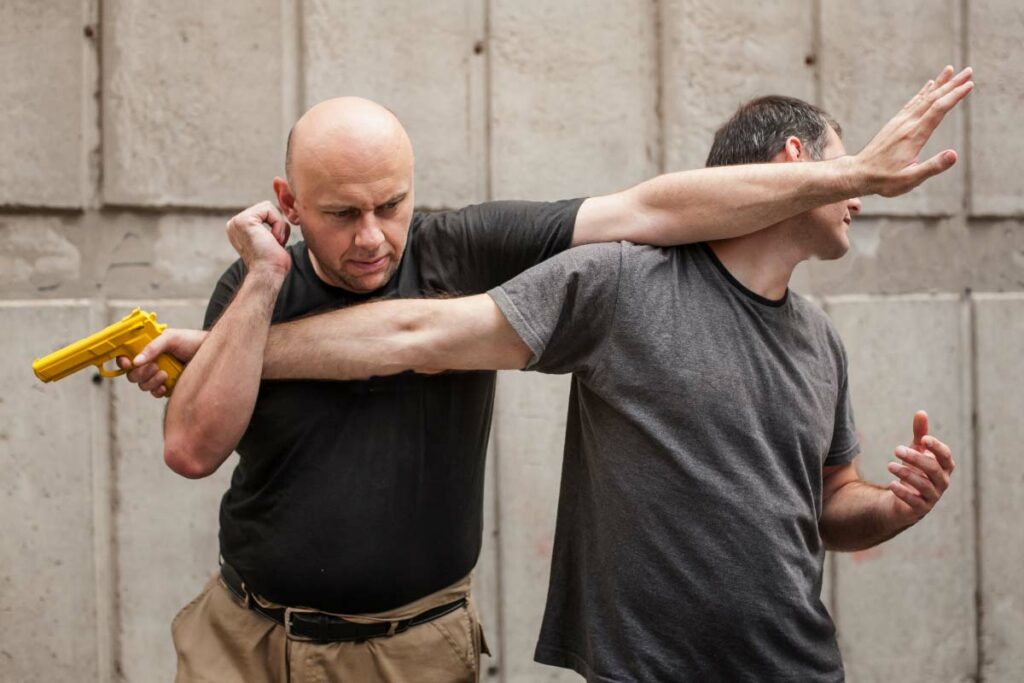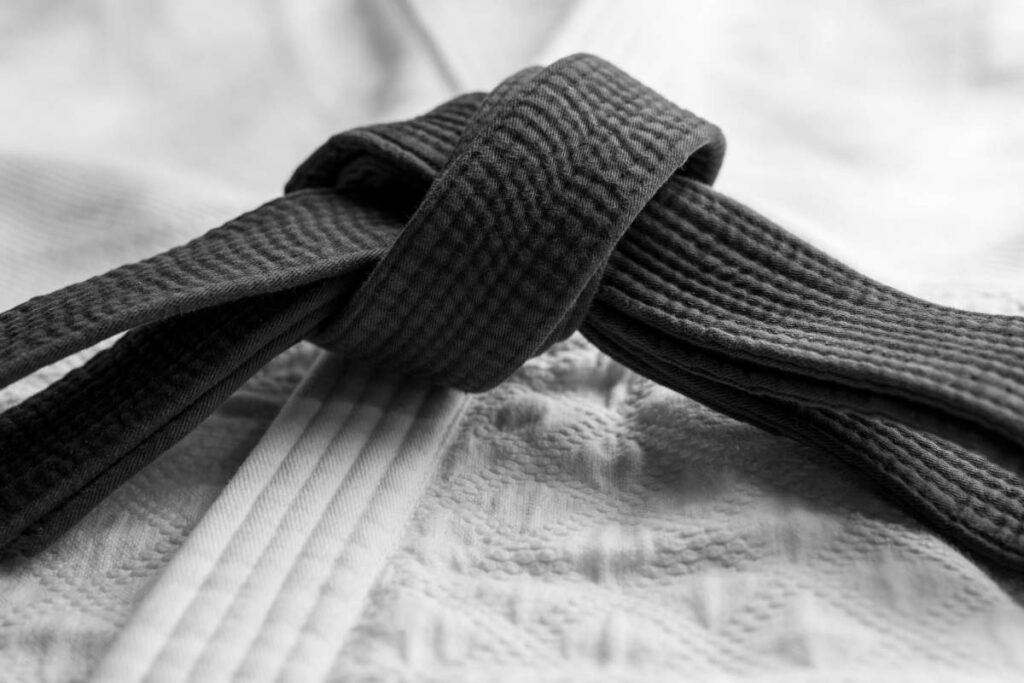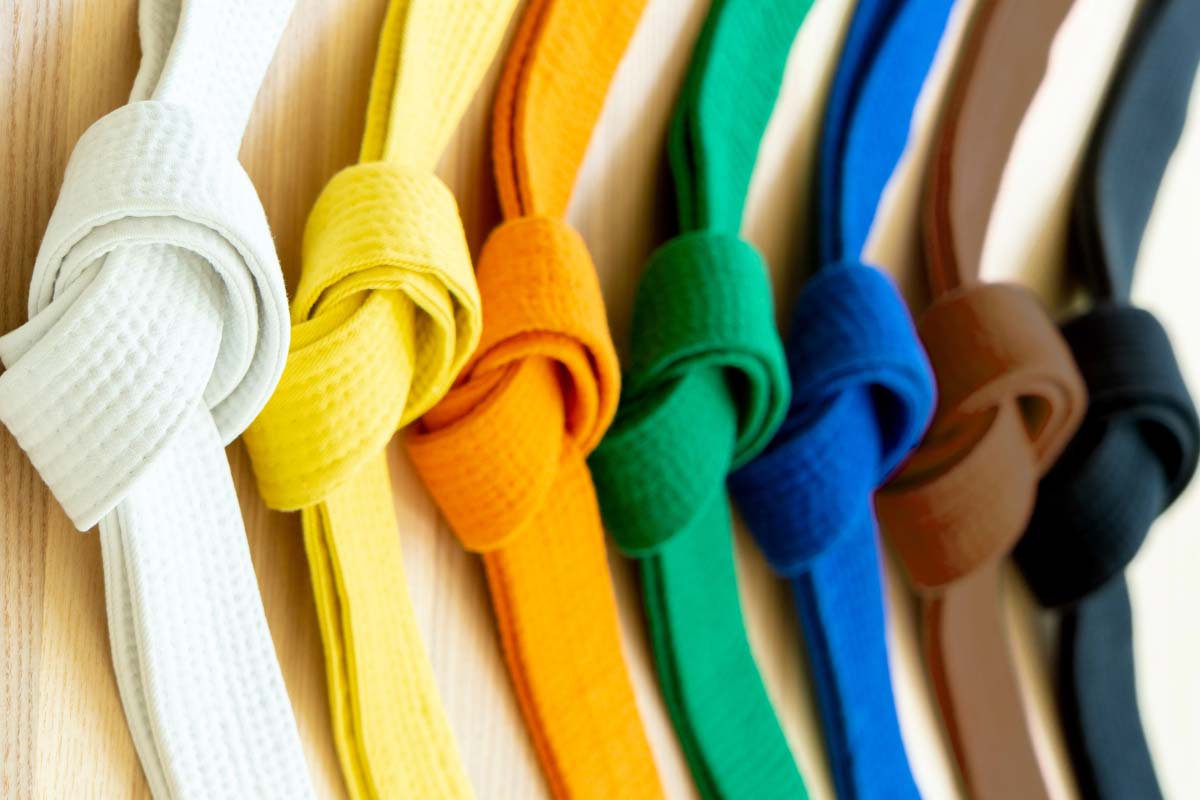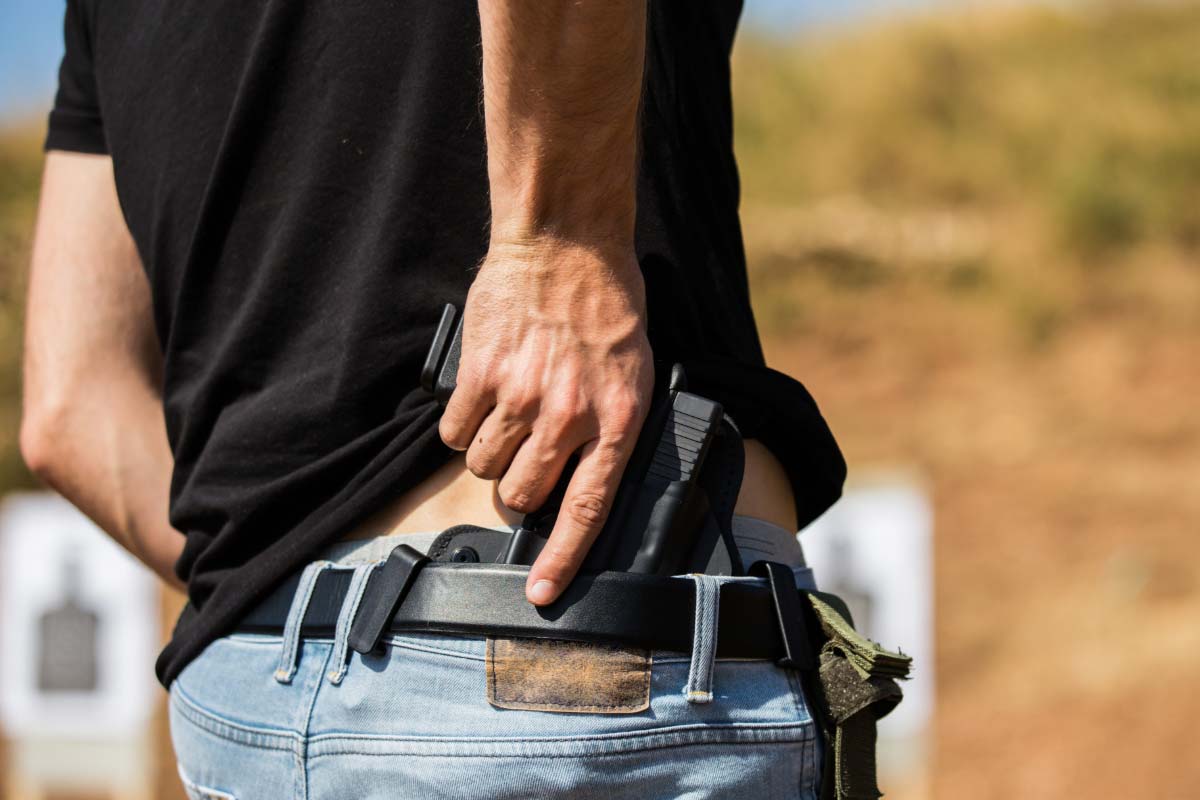What to learn about the Krav Maga belt system?
Learn the meaning behind each belt color, the requirements for progression, and the overall structure of ranking within the discipline.
Whether you’re currently practicing Krav Maga and want to advance your training, or if you’re considering taking up Krav Maga this is for you.
We’ll break down the belt progression system in detail and cover what is expected at each level.
This article covers:
Krav Maga Belt System Overview
The belt system in Krav Maga symbolizes a practitioner’s progress through the training structure.
As a practitioner advances, they achieve different grades represented by belts of various colors.
The Krav Maga Worldwide system is typically structured with six primary belts: Yellow, Orange, Green, Blue, Brown, and Black.
Progress to each belt involves completion of certain levels that correspond with a mastery of skills. Yellow signifies the entry point at Level 1, where foundational self-defense techniques and striking skills are taught.
Orange, achieved after Level 2, signifies a deeper understanding and enhanced skills.
Advancement to Green and Blue belts, following Levels 3 and 4 respectively, represents the development of advanced self-defense tactics and combinations.
The Green belt is a transition point where students hone their skills further, and by the time they reach Blue, they are well-versed in various striking combinations and defenses against weapons.
The Brown belt follows completion of Level 5 and is evidence of a high level of proficiency. It demonstrates that a student has a comprehensive understanding of Krav Maga principles and the physical capability to execute techniques under stress.
Lastly, the coveted Black belt marks an expert level of skill, reflecting extensive training and dedication to the practice of Krav Maga. This level often requires invitation-only testing and indicates that one is not just a student but an adept practitioner of the discipline.
Belt Ranking and Levels
This video gives a fantastic, detailed comparison of the ground fighting skills you should have at each Krav Maga level when compared to Brazilian Jiujitsu by belt color.
For example, someone that trains at the advanced level 5 in purely Krav Maga is likely to have a comparable ground game to a BJJ blue belt (the first belt you earn in Jiujitsu).
While the blue belt level is considered advanced in the Krav Maga system (it’s the 4th belt your earn), it is merely the first belt you earn in Jiujitsu.
The Krav Maga belt system is a structured framework indicating a practitioner’s progression and level of expertise with a set of techniques outlined in the curriculum.
Here is a quick summary of the belt color and level it corresponds to:
| Belt Color | Level | Skill |
|---|---|---|
| White | Level 1 | Beginner |
| Yellow | Level 2 | Advanced Beginner |
| Orange | Level 3 | Intermediate |
| Green | Level 4 | Advanced |
| Blue / Brown / Black | Level 5 | Expert |
White Belt: Introduction Level 1
The White Belt is the first stage in Krav Maga, serving as an induction into the basic principles and techniques of the discipline. You become a white belt the day you step on the mats.
Yellow Belt: Novice Level 2
A novice practitioner earns the Yellow Belt after completing Level 1. It signifies an understanding of essential self-defense techniques and beginning to build upon physical conditioning and Krav Maga fundamentals. You should understand fight stance, basic movement, and basics combatives (striking options) as well as basic defenses against as common choke attacks.
Orange Belt: Beginner Level 3
The Orange Belt marks the beginner’s transition into a more sophisticated level of training. It requires completion of Level 2, where one learns to refine the techniques and apply them with increased confidence. At this level, you should understand basic striking combos, more advanced defenses, and will introduced to more advanced drills.
Green Belt: Intermediate Level 4
Achieving the Green Belt reflects an intermediate level of proficiency. The practitioner has dedicated substantial time to training, often around nine months, and can perform Krav Maga techniques with competence and efficiency.
You should have some exposure to weapons defenses and basic ground fighting skills with an understanding of positions, basic submissions, and escapes.
Blue Belt: Advanced Level 5
The Blue Belt is awarded upon reaching an advanced skill level in Krav Maga, representing a deeper understanding of more complex techniques and the ability to control confrontations under various conditions.
At this level, you are considered well on your way to becoming an expert.
You should be able to demonstrate proficiency with weapons defenses and apply Krav Maga principles for fighting in disadvantaged situations such as against multiple attackers.
Brown Belt: Expert Level 5 (Continued)
As an expert, the Brown Belt holder demonstrates comprehensive knowledge and skill. This level is about refining advanced techniques and applying Krav Maga principles fluidly in any scenario.
You should demonstrate mastery of weapons defenses including guns, rifles, knives and sticks. You should be competent in defending against multiple attackers and have a well-rounded skill set in standup striking as well as fighting on the ground and executing takedowns.
Black Belt: Mastery Level 5 (Continued)
Attaining the Black Belt symbolizes mastery of the Krav Maga system. It encompasses expert knowledge, skillful execution of techniques, and the embodiment of Krav Maga’s philosophy and fighting spirit. You should be able to execute all techniques of the full curriculum and extreme duress.

Training and Curriculum
The Krav Maga belt system is structured around a progressive curriculum, focusing on practical skills and real-life scenarios. The training is designed to develop physical conditioning, tactical thinking, and self-defense proficiency.
Techniques and Skills Development
In Krav Maga, students begin by learning fundamental techniques that form the building blocks for more advanced skills. They practice strikes, blocks, and evasions as key elements of the curriculum. The focus is on quick learning and application of moves that can be effectively used in various situations.
Self-Defense Techniques
The curriculum places a strong emphasis on self-defense techniques that are both intuitive and effective. Students are taught how to respond to a range of attacks, including chokes, grabs, and bear hugs. They learn not only the mechanics of the technique but also the timing and distance management crucial for self-defense.
Weapons Defenses
Krav Maga incorporates defenses against common weapons such as knives, guns, and sticks. These weapons defenses are practiced with safety and realism in mind. The goal is to provide students with the skills to disarm or neutralize the threat of a weapon. While you will get some weapons exposure at lower levels, mastery of weapons defenses is expected at more advanced levels such as blue belt and higher.
Sparring and Combat Practice
Sparring and combat practice in Krav Maga are designed to simulate real confrontations. Practitioners engage in controlled sparring sessions, which improve their reflexes, situational awareness, and ability to apply techniques under stress. This experience is integral to the training and helps prepare students for real-life self-defense situations.
Testing and Advancement
In Krav Maga, testing is a structured process designed to assess a student’s proficiency at various levels of expertise.
Each belt test is specifically aimed to evaluate both the mental and physical preparedness required for advancement.
Belt Tests and Requirements
The pathway to progression in Krav Maga starts with a Level 1 test, where students work towards earning the Yellow Belt. It typically involves a period of about four months of dedicated training.
By the time they reach the Level 2 test for the Orange Belt, which may take an additional six months, students are expected to have refined their techniques and tactical skills.
The subsequent levels—Level 3 and Level 4—involve testing for the Green and Blue Belts respectively, with each stage demanding a higher standard of technical and situational awareness.
Tests for Level 5 introduce students to the Brown and Black Belt levels, the pinnacle of Krav Maga’s ranking system. For more specifics on the belt system, refer to Krav Maga Worldwide’s detailed Krav Maga belt system.
Criteria for Progression
Advancement in Krav Maga is less about the time spent and more about the mastery of specific skills and techniques.
For students to progress from one level to the next, they must demonstrate a comprehensive understanding of the curriculum presented at their current level.
Additionally, Krav Maga’s belt system takes into account a student’s ability to apply learned techniques under stress, ensuring their readiness for real-world self-defense scenarios.
The testing criteria are stringent, ensuring that only well-prepared individuals are awarded the next belt in the sequence.
Mental and Physical Preparedness
Mental fortitude is just as crucial as physical prowess in Krav Maga.
Students are evaluated on their capacity to stay calm, think clearly, and execute techniques efficiently under duress.
The testing process seeks to confirm that a student not only has the physical conditioning but also the mental resilience to handle confrontations and push beyond your comfort zone.
No actual belts may be given out in some schools, such as those under Krav Maga Worldwide. However, belt testing emphasizes the acknowledgment of a student’s growth in both mental and physical aspects of self-defense.
Krav Maga Practitioner Journey

The Krav Maga belt system represents a structured path from beginner to expert, each level denoting a significant milestone in skill and knowledge. Earning each belt requires dedication, reflecting a practitioner’s growth in proficiency and understanding of this combat system.
From Novice to Master
A Krav Maga practitioner begins as a novice at the yellow belt level, learning the fundamentals. Progress to each subsequent belt – orange, green, blue, brown, and ultimately, black – is a result of training and mastery of more complex techniques. Practitioners often spend a substantial period at each rank, demonstrating not only skill but also leadership and teaching capabilities before advancing.
Road to Black Belt
Earning your Krav Maga black belt takes many years of dedication, patience, and hard training. You’ll literally sacrifice blood, sweat, and tears along the way.
There’s a popular expression in the Krav Maga community that goes:
How long does it take the average person to earn their Krav Maga black belt?
The average person will NEVER earn a Krav Maga black belt.
The road to achieving your black belt is such a difficult pursuit that it takes a an extraordinary person to accomplish this. This is not possible for the average person.
The time it takes to earn a black belt in Krav Maga can vary widely depending on several factors, including the specific organization’s curriculum, the frequency and intensity of training, and the individual’s prior experience and learning pace.
Generally, it can take anywhere from 5 to 10 years of consistent training to achieve a black belt in Krav Maga. This estimate accounts for the progression through various levels or belts, with students typically training multiple times a week.
The guideline for the amount of hours spent training at each level is as follows white to yellow belt takes about 40 hours of training at minimum, yellow to orange 60 hours, orange to green about 80 hours, and so on.
General guidelines for required training hours:
- White to yellow – 40 hours)
- Yellow to oragnge – 60 hours
- Orange to green – 80 hours
- Blue / brown / black – over 100 hours at each level
Regardless of the number of training hours, you are expected to be at the brown belt level for at least a year or two before you are eligible for invitation to test for the black belt.
Continual Learning and Improvements
The journey in Krav Maga is ongoing, with the ranking system designed to foster continuous improvement. It emphasizes the importance of adapting to evolving self-defense situations, upgrading skills, and refining strategies over time. Each belt achieved marks a new chapter in a practitioner’s development, with a focus not just on physical ability but strategic thinking as well.
Training Consistency
Defensive skills are perishable. As with most skills, they diminish overtime with consistent practice and training. Regular, disciplined practice ensures that practitioners can apply Krav Maga techniques reflexively and effectively when needed.
Organizations and Recognition
Krav Maga, renowned for its effectiveness in real-world self-defense, is governed by various organizations, each upholding specific belt ranking systems. These entities not only standardize training curricula but also officially recognize practitioners as they advance through different proficiency levels.
Diplomas or certificates, signed by the chief instructor, are typically awarded to a student after successful completion of a belt test.
International Krav Maga Federation
The International Krav Maga Federation (IKMF) stands as one of the leading bodies in the legitimization and dissemination of Krav Maga on a global scale.
Their belt system follows graded levels that signify a practitioner’s progression in mastering the discipline.
The IKMF’s recognition is held in high esteem, and their straightforward rank structure allows students to develop and achieve expertise methodically.
Israeli Krav Maga Association
Alternatively, the Israeli Krav Maga Association (IKMA), also known as Gidon System, takes pride in a more traditional approach to the martial art.
The IKMA, while similar in instructional rigor, may have slight variations in their ranking system when compared to the Krav Maga Worldwide (KMW) organization.
The latter, founded by Darren Levine, offers a distinct belt system starting with Yellow and culminating in the esteemed Black Belt, with a lineage tracing back directly to the founder of Krav Maga, Imi Lichtenfeld.
The IKMA’s recognition holds significant weight in Israel and across the world for its authenticity and close ties to Krav Maga’s origins.
Do you train in Krav Maga? If so, what’s your belt ranking? Leave a comment below.







